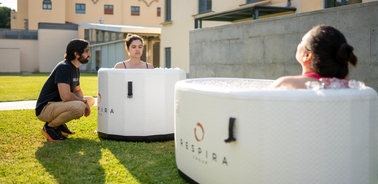The Wim Hof Method: extreme stress management with remarkable benefits

Breathing through the stress is the key to relaxation and well-being.
We’re facing unprecedented levels of stress today. Gallup’s State of the Global Workforce 2023 Report showed that 44% of employees worldwide were stressed—reaching record highs that have been climbing steadily over the last decade.
For millennia, societies in different parts of the world have espoused the benefits of controlled breathing for holistic well-being. Ancient yogis developed the practice of Pranayama, aiming to control their “life force” through breath regulation, reduce stress, and balance the mind and body. Similar concepts are prevalent in other diverse cultures, from qi, qigong, and taixi in Taoism and traditional Chinese medicine, to zazen in Japanese Zen Buddhist tradition and sekhem, which is linked to meditative practices from ancient Egypt.
The Wim Hof Method is a comparatively new addition to the health and wellness scene. Proponents of the technique swear by its benefits, but is it rooted in science? Can deep, regulated breathing really play a role in your well-being? Let’s explore.
What is the Wim Hof Method?
The technique provides numerous health benefits by incorporating breathwork, cold therapy, and a strong mental commitment. These three distinct pillars impact your body in different ways:
Controlled breathing
This pillar harnesses the power of the innovative Wim Hof breathing technique, which involves a series of deep inhalations and rapid exhalations—some describe it as “hyperventilating”—and sustained breath holding. The main goal of Wim Hof breathing is to boost the amount of oxygen in the body, leading to a host of health benefits.
Cold therapy
This is perhaps the most unique element of the Wim Hof Method. It requires you to plunge yourself into cold temperatures ranging between 10°C to 15°C (50°F to 59°F) for several minutes. There are several ways to accomplish this, from costly alternatives like enclosed cold-air chambers to more affordable options like cold showers, walks in brisk weather, or ice baths, which have become quite popular online.
Commitment
Practicing the Wim Hof Method can be an overwhelming challenge for most without a strong commitment. The technique emphasizes the fact that it isn’t a quick fix but the start of a wellness journey that requires persistence, determination, making adjustments, and, most importantly, time. In fact, many practitioners meditate regularly as a way to increase willpower.
This technique was developed by the “Iceman” Wim Hof, a Dutch extreme athlete best known for breaking records with incredible feats like running barefoot through snow and swimming under ice for prolonged periods.
Hof sees his method as a meditative approach to improving well-being. It revolves around the concept that you can use the three pillars to control different parts of your autonomic nervous system (ANS), which handles unconscious activities like breathing, digestion, and even temperature regulation.
Some may call it extreme, but the Wim Hof Method has garnered a devoted following among holistic health enthusiasts. This can be primarily attributed to claims that the technique reduces stress and boosts immunity while leading to better sleep and greater mental clarity. But is there any research to prove it?
Explaining the science behind the Wim Hof Method
As it turns out, the Wim Hof Method is a scientifically supported technique. Researchers around the world have been exploring its benefits in diverse scientific settings, providing irrefutable proof of the advantages of this breathwork-based wellness technique.
Several studies have been made in this area over the last decade; here are a notable few:
In 2024, Dr. Omar Almahayni and Dr. Lucy Hammond conducted a systematic review of the beneficial impacts of the Wim Hof Method on physiological and psychological health. They found that the method increased epinephrine production in both healthy and non-healthy participants, reducing inflammation and inflammatory responses. Results related to its effect on sports performance were mixed, and the researchers suggest that this could be a valuable topic for further research.
In 2023, Sascha Ketelhut et al. studied the effect of the Wim Hof Method on cardiac function, blood pressure, arterial health, and mental well-being. While they couldn’t prove any significant physiological benefits, they found that the technique had a measurable positive impact on certain psychological parameters.
In 2021, Tom Citherlet, Fabienne Crettaz von Roten, Bengt Kayser, and Kenny Guex studied the method’s effects on sprinters, and found that the technique was quite effective at removing expired carbon dioxide from the body.
In a 2014 study, Matthijs Kox et al. analyzed the effects of meditation, cold exposure, and breathing techniques on the sympathetic nervous system (SNS). They found that participants who regularly practiced these techniques could indeed voluntarily affect their SNS, leading to an increased anti-inflammation response in their bodies.
The power of breath: What are the benefits?
From this brief overview, the Wim Hof Method presents clear physical and mental improvements with regular practice. Coupled with meditative practices that enhance your mental well-being, you may experience numerous benefits from this unique technique:
Reduced inflammation, through positive impacts on your brain’s neurotransmitters;
Decreased instances of flu-like symptoms due to a stronger immune response;
Increased oxygenation may enhance sports performance and help when adjusting to higher altitudes;
Reduced blood pressure, due to the method’s positive effects on vasodilation and vasoconstriction.
Participants also reported various other benefits, especially when they complemented the technique with other well-being practices like yoga and meditation. These include:
Reduced stress levels;
Better sleep;
Increased energy levels;
Heightened clarity and focus;
Greater willpower;
A strengthened immune system.
Incorporating the Wim Hof Method for daily well-being
Whether you’re studying or working in the professional world, it’s relatively easy to add the Wim Hof Method to your daily routine. Consider starting your day with some Wim Hof breathing exercises, and give yourself a quick midday energy boost to help you deal with meetings, presentations, or classes.
Here’s a simple guide to get you started with practicing Wim Hom breathing:
Step 1: Take a long, strong inhale through your nose.
Step 2: Release a soft, relaxed exhale through the mouth.
Step 3: Repeat this cycle for 30 breaths.
Step 4: Exhale the last breath to 90 percent, then hold for as long as possible.
Step 5: Once you feel that your body really needs a breath, inhale fully, hold for 15 seconds, and release.
These five steps represent one round of Wim Hof breathing, and the basic technique calls for three consecutive rounds.
You can also replace warm showers with cold ones at least once a day to unlock the advantages of cold therapy.
Breathing for the win!
Adopting the Wim Hof Method doesn't just cut stress levels dramatically, it allows students and professionals to lead balanced, healthier lives. As you juggle your responsibilities at home, school, or work, starting small and staying consistent will ensure you experience its full benefits.
You can also join IE University for a series of events on this technique to help you get started on the right foot. On October 16th, IE Center for Health & Well-Being will host an outdoor session led by Felipe Galvis, CEO at Breathe for Performance, to help you reconnect with nature—and yourself. Or, take advantage of the second session on October 17th in case it aligns better with your schedule. We look forward to seeing you there!

